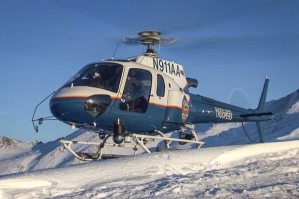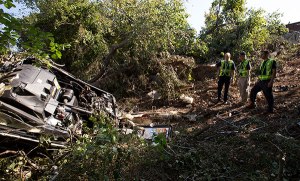A helicopter pilot died disoriented and confused in Alaska on March 30, 2013.
He was no novice; in fact, he was flying a search-and-rescue mission for the Alaska Department of Public Safety (DPS). But when he set out – highly motivated to save the life of a stranded snowmobiler – he set in motion a chain of events that ended in three deaths: His own, the snowmobiler’s, and that of an Alaska State Trooper serving as an observer.
 The pilot was qualified to fly search and rescue missions in visual meteorological conditions but not instrument meteorological conditions in the accident helicopter. Ultimately he found himself in instrument meteorological conditions, in a helicopter that was neither equipped nor certified for instrument flight rules. Minutes after picking up the stranded snowmobiler, he became spatially disoriented, lost control of the helicopter and crashed.
The pilot was qualified to fly search and rescue missions in visual meteorological conditions but not instrument meteorological conditions in the accident helicopter. Ultimately he found himself in instrument meteorological conditions, in a helicopter that was neither equipped nor certified for instrument flight rules. Minutes after picking up the stranded snowmobiler, he became spatially disoriented, lost control of the helicopter and crashed.
The pilot and the trooper who died in this crash died in the service of others. They routinely shouldered risk in the line of duty to enhance the safety of their fellow Alaskans. But risks that should have been weighed systematically and objectively were assessed subjectively and individually. The pilot’s training was not in line with the conditions of his mission. His flight observer was not a trained tactical flight officer who could have better assisted with aeronautical tasks. The Alaska DPS was not using formal flight-dispatch and flight-following procedures that included up-to-date weather information and assistance with risk-assessment decisions.
During the NTSB’s accident investigation, even before we issued our final report, the Alaska DPS responded to the lessons that were coming to light and implemented a number of safety improvements. All Alaska DPS pilots who fly the type of helicopter involved in this accident were required to receive training in how to safely escape from an inadvertent encounter with instrument meteorological conditions; formal risk assessments were required before any helicopter missions are initiated; and a formal tactical flight officer training program was developed. At the time the NTSB report was issued, flight-tracking equipment was installed in 34 of the 42 aircraft in the Alaska DPS fleet, with plans to soon have this equipment installed in the entire Alaska DPS aircraft fleet. Finally, organizations within the Alaska DPS were assigned responsibility for using this equipment to perform flight following for all Alaska DPS aircraft flying missions.
Many of the recommendations that the NTSB made in the accident report related to sharing the lessons of the Talkeetna accident beyond the state of Alaska. Why? The Alaska DPS moved admirably and with great purpose after it experienced the accident. Yet the Talkeetna accident had many commonalities with crashes of Maryland State Police and New Mexico State Police helicopters in 2008 and 2009 respectively. And public helicopter operations accidents are by no means limited to law enforcement. We also investigated the 2010 collision of a California Department of Fish and Game helicopter with power lines.
As in the case of the Alaska DPS, in many cases, the states in which these accidents occurred have learned from their mistakes, and have raised the bar for safety in their public helicopter operations.
But states with public helicopter operations are not learning from each other. In the Talkeetna accident, we recommended that 44 additional states, the Commonwealth of Puerto Rico, and the District of Columbia familiarize their public helicopter operators with the lessons of all three accidents.
Substitute the name of your state for “Alaska” in the first line of this article. Then ask yourself what your state is doing to guarantee the safety of its public helicopter operations, with the most recent NTSB recommendations in mind.
If you work in public helicopter operations, the odds are that there are NTSB recommendations pending in your state. Have you heard about, or been involved in, favorable actions on those recommendations? If not, reach out to colleagues.
States feeling the budget pinch nevertheless find ways to make changes after lives are lost. But actions now may save lives instead.
Many of those who are involved in public helicopter operations put their lives on the line in the service of others. These NTSB recommendations are intended to prevent extra, unnecessary risk to the brave men and women who do so, and their passengers.
Earlier NTSB reports on public helicopter operations are also available at NTSB.gov.






